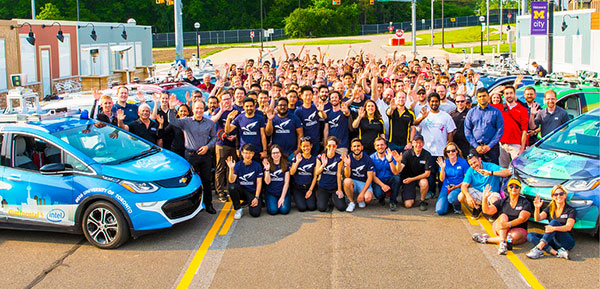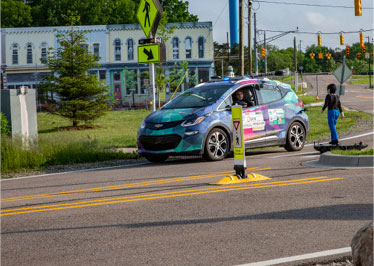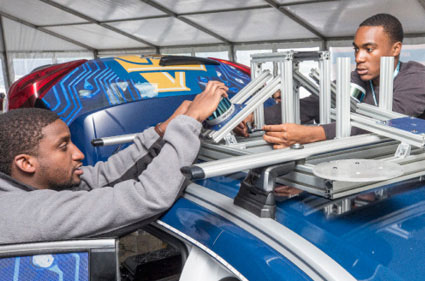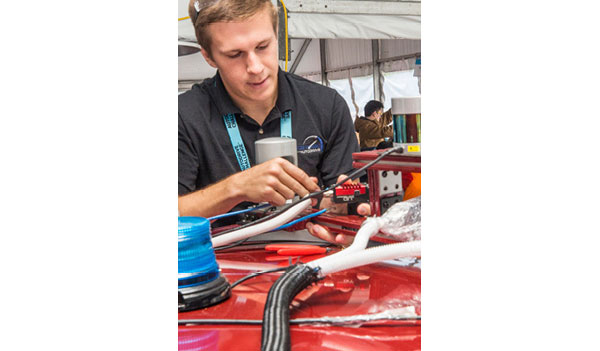
The SAE AutoDrive Challenge consists of eight teams from select universities that were invited to participate in the inaugural competition. Image courtesy of SAE International/GM Motors.
March 29, 2021
SAE International and General Motors have partnered to headline sponsor AutoDrive Challenge, the latest of SAE International’s Collegiate Design Series. This newly established, four-year autonomous vehicle competition tasks eight university student teams to develop and demonstrate a full autonomous driving passenger vehicle.
Allison Hostetler is the director of pre-professional education at SAE International. We spoke to Allison to get a better understanding of their competition.
Digital Engineering: Can you provide an overview of the AutoDrive Challenge competition, how it came to be and the intent of the program? Who will be participating or who has participated? How many participants have you had or are you expecting? Any demographics of participants?
Allison Hostetler: The technical goal of the competition is to navigate an urban driving course in an automated driving mode as described by SAE Standard (J3016) Level 4 definition in the fourth year of the competition.

Throughout the AutoDrive Challenge competition cycle, students and faculty will be invited to attend technology-specific workshops to help them in their concept refinement and overall autonomous technical understanding. The competition consists of eight teams from select universities that were invited to participate in the inaugural competition.
Year 1 (2018) focused on the concept selection for the university teams by having them become familiar with their sensing and computation software. They were tasked with completion of a concept design written paper as well as simple missions for on-site evaluation in Yuma, AZ.
Year 2 (2019) focused on urban driving scenarios with static and dynamic objects. Teams will complete these test at Mcity, a one-of-a-kind urban test facility at the University of Michigan that simulates a broad range of complexities that vehicles encounter in urban and suburban driving settings.
Year 4 (2021) is the last year of this inaugural series of the AutoDrive Challenge competition and will challenge the teams to show what the previous three years of development and learning has produced. The teams will face two dynamic challenges in this last year. One will be a culminating drive that links together all the elements and features experienced in the previous three years. The second will be SAE Standard (J3016) Level 4 proof of concept demonstration drive.
Additionally, teams will be required to generate reports, presentations and perform simulations to highlight their work and communicate what they have learned.
DE: Can you tell us about some of the designs that are part of the event and how they came to be?

Hostetler: The competition focuses on each university team receiving a standard Chevy Bolt EV; [they] are tasked with integrating autonomous sensors and building a software and hardware architecture. Each team uses an Intel Compute Platform to power their autonomous driving along with LIDARs, radars and cameras that make up their sensor suite. Although each team has access to all the components mentioned, each of the eight designs are unique and each team approached their architecture and achieving dynamic challenges differently. Each team was also given simulation software and competed in a MathWorks Simulation Challenge designed to mirror the Mcity landscape for real simulated testing.
DE: Can you provide some examples of what the event has produced or what you expect it to produce?
Hostetler: Year 3 (2020) of the AutoDrive Challenge Social Responsibility project tasked teams to help SAE bridge the academia gap and develop a standard for autonomous mobility that includes accessibility. Teams were tasked to research, analyze and standardize their best practice autonomous vehicle design that provides a safe and operationally user-friendly environment for the general public, which includes disabled citizens.

Year 4 (2021) AutoDrive Challenge Social Responsibility is asking teams to help SAE bridge the academia gap and write a 10-15-page white paper for application of their standard from Year 3, that focused on a topic in autonomous mobility that includes accessibility. Teams are tasked to present a white paper to standardize their best practice autonomous vehicle design that provides a safe and operationally user-friendly environment for the general public, which includes disabled citizens.
DE: Does the AutoDrive Challenge have a particular stance on adopting an innovation that is linked to the program?
Hostetler: SAE International is excited to expand upon our already strong partnership with General Motors to build the future STEM workforce through the AutoDrive Challenge. This relationship builds on our success through STEM programs such as Formula SAE and our A World In Motion (Pre-K to 8th Grade) programming, the AutoDrive Challenge launches a new platform to engage industry and academia in working towards a common goal of preparing the brightest young minds for the future of autonomous technologies.
AutoDrive Challenge is another way General Motors is educating and training next generation of automotive engineers and advance the workforce development in automation and automated vehicles. Through the partnership, SAE and GM offer a unique experience for students to work with industry professionals to tackle the next big opportunity facing vehicle technology: autonomous driving.
Subscribe to our FREE magazine, FREE email newsletters or both!
About the Author
Jim Romeo is a freelance writer based in Chesapeake, VA. Send e-mail about this article to [email protected].
Follow DE




